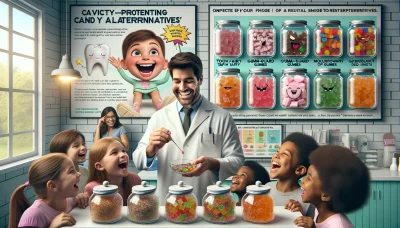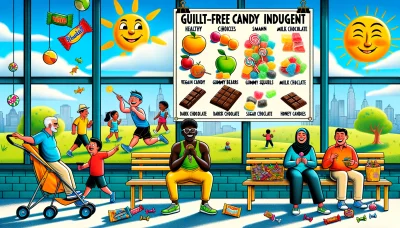Candy for Managing Hypoglycemia Quiz
Test Your Knowledge
Question of
Understanding Hypoglycemia
There's something so human about reaching for a sweet treat when you're feeling lowliterally. Hypoglycemia, that sneaky dip in blood sugar, can catch you off guard, leaving you feeling like a deflated balloon at a birthday party. But before we talk about the potential role of candy in managing those sugar levels, let's dive into the root of this uninvited guest.
Hypoglycemia isn't just a fancy word for craving sweetsit's a real condition that can cause quite a bit of drama. It's the moment your body turns into a petulant child, demanding immediate attention and care. And while it may seem simple to just grab a piece of candy and move on, understanding why your blood sugar has decided to take a nosedive is crucial in managing your health with both grace and wisdom.
Causes of Low Blood Sugar
Let's peel back the layers of this onion. The causes of hypoglycemia are as varied as the candy aislecomplex and often overwhelming. At its core, low blood sugar can be the result of an overzealous pancreas that pumps out more insulin than your body knows what to do with. This insulin overproduction is like an overeager friend who depletes all the snacks at your party before anyone else gets a chance to indulge.
Then there are those pesky medication side effects, which can sneak up on you like hidden calories in a seemingly innocent treat. Certain medications might tip the scales and send your blood sugar plummeting without so much as a warning label. And let's not forget dietary imbalancesthe culprits that turn your body's harmony into chaos, leaving you vulnerable to unexpected lows.
- Insulin Overproduction: When your pancreas goes on an insulin spree.
- Medication Side Effects: When treatment plans have an unexpected twist.
- Dietary Imbalances: When your eating habits throw you off balance.
Recognizing Hypoglycemia Symptoms
Awareness is key when it comes to hypoglycemia. Think of it as knowing exactly where the emergency chocolate stash is located. Recognizing the physical warning signs is like understanding the language of your body when it whispers (or screams) for help. You might feel shaky, sweaty or as if you're starring in your own personal earthquakenone of which are particularly fun episodes.
The cognitive indicators are no laughing matter either; they can make you feel like you're trying to think through a fog made of cotton candythick and disorienting. It's important to pay attention to these mental signs because they can affect everything from how you perform at work to how safely you can drive home from the grocery store.
Beyond these immediate symptoms, there are long-term health implications that shouldn't be ignored. Just like overindulging in sweets can lead to issues down the road, repeated episodes of hypoglycemia can have lasting effects on your well-being. So while reaching for that quick sugar fix might offer temporary relief, being mindful of the bigger picture is essential.
Best Types of Candy for Blood Sugar Management
Chewable Candies
There's something quite nostalgic and, dare I say, comforting about chewing on a piece of candy. The texture, the burst of flavorit all comes together in a symphony that not only delights the senses but also serves a practical purpose for those managing hypoglycemia. When blood sugar levels begin to dip, as someone who has had their fair share of close calls, I've learned to appreciate the quick solace that chewable candies provide.
Among the myriad of options, glucose gels have been my discreet companions during long meetings and hikes. Unlike other treats, they're designed specifically for moments when you need to boost your blood sugar efficiently. They're like little packets of energy that fit snugly in my pocket, ready to lend their sweetness when needed. But it's not just about utility; there's a certain childlike joy in squeezing out the last bit of gel and feeling it dissolve on my tongue.
Glucose Gels
The effectiveness of glucose gels is undeniable. Their concentrated glucose is rapidly absorbed, making them an excellent choice for anyone looking to manage low blood sugar episodes with precision. While they might not win any gourmet awards, they are lifesavers in their own rightfunctional candy at its finest.
Jelly Beans
Then there are jelly beanstheir glossy shells hiding a burst of sugary goodness within. It's almost like playing roulette with flavors; each color brings a new experience. But beyond their playful exterior lies a reliable source of fast-acting carbohydrates, perfect for those moments when my body signals the need for something sweet and swift.
Gummy Candies
Gummy candies are another ally in this sugary arsenal. They stick to your teeth, reminding you with every chew that relief is on its way. The way they squish between your teetha tactile reminder that help is at handis oddly satisfying.
Hard Candies
Moving on from the chewy delights to the hard candiesthose shiny little orbs of happiness that clink against your teeth and take their time to unveil their sweet essence. Hard candies are the marathon runners in the race against hypoglycemia; they offer a steady stream of sugar over time, perfect for those who prefer a controlled increase in blood glucose levels.
Lifesavers have been just thata lifesaveron more than one occasion when I've felt my energy wane at an inconvenient moment. Their name isn't just clever branding; it's a testament to their ability to come through when you need them most.
Lifesavers
Their ring shape isn't just whimsical; it's practical tooeasy to hold onto even when your hands are shaky from low blood sugar. And let's be honest, there's something deeply satisfying about popping one into your mouth and letting it slowly dissolve away your worries along with your hypoglycemia.
Peppermints
Peppermints bring more than just sweetnessthey come with a refreshing zing that can invigorate the senses as much as they soothe the sugar cravings. Theres nothing quite like that cool sensation spreading through your mouth as you crunch down or let it melt away slowly.
Lollipops
Last but not least are lollipopsthe quintessential childhood treat that doubles as a blood sugar stabilizer on-a-stick. Holding onto one makes me feel armed against hypoglycemiaan empowering feeling indeed! Plus, twirling one around while going about my business adds an element of fun to what could otherwise be a stressful situation.
- Joyful savoring as they take time to finish
- A visual reminder to take things slow and steady
- The stick serves as a handle for trembling fingers during a sugar drop
- Variety of flavors catering to every mood and preference
In conclusion (though I promised not to), indulging in these treats is more than just about managing blood sugarit's about reclaiming moments of pleasure amidst life's unexpected turns. It encourages us to find joy in simple indulgences and empowers us with small tools for self-care. So heres to savoring those little pleasuresone sweet bite at a time!
Timing and Dosage Considerations
There's a whimsical irony in turning to candy, those sweet morsels often blamed for health woes, as a guardian against the shaky, sweat-drenched grip of hypoglycemia. Yet, here we are, sugar warriors, armed with jelly beans and peppermints, ready to combat those unnerving lows. Timing, my fellow glucose guardians, is as crucial as the choice of candy itself. A well-timed sugary intervention can be the difference between a quick bounce back and an overcorrection that sends your blood sugar on a roller coaster ride more thrilling than anything at the amusement park.
When to Use Candy for Hypoglycemia
There's a certain art to knowing when to reach into your pocket for that emergency stash of gummy bears. It's not just about treating hypoglycemia; it's about preempting it with grace and precision. Imagine you're an undercover agent in a high-stakes situation except your mission is to keep those blood sugar levels from dropping too low.
Pre-Exercise Snacking
Before you lace up those sneakers and hit the pavement or the gym, consider this: your muscles are about to embark on a glucose-gobbling spree. A small handful of candy can serve as a quick source of energy, fueling your workout while keeping hypoglycemia at bay. It's like giving your body a little pep talk before the big game.
During Sudden Drops in Blood Sugar
A sudden drop in blood sugar can feel like an unexpected plot twist in your day. Whether you're navigating the aisles of the grocery store or deep in thought during a meeting, that telltale dizziness or irritability is your cue to act. At moments like these, candy becomes more than just a treat it transforms into a lifeline.
Post-Meal Corrections
Sometimes, despite our best calculations, insulin and food dance to their own unpredictable rhythm. When you find yourself with lower-than-expected post-meal blood sugars, reaching for a piece of candy can offer a quick fix. It's like smoothing out the creases on a freshly made bed simple and satisfying.
How Much Candy to Consume
The amount of candy one should consume when managing hypoglycemia is akin to finding the perfect volume on your stereo; too low and you can't hear the music, too high and you might blow out the speakers. The goal is that sweet spot where everything sounds just right.
Calculating Carbohydrate Needs
To tailor your sugar intake precisely requires some number-crunching finesse. You'll need to know how many grams of carbohydrates are necessary to nudge your blood sugar back into its comfort zone without overshooting the target. It's like being both the chef and the nutritionist in your own personal candy kitchen.
Serving Sizes and Labels
You might think that estimating serving sizes is as easy as "one for you, two for me," but when managing hypoglycemia with candy, accuracy matters. Reading labels becomes second nature each gram of carbohydrate meticulously accounted for as if you were deciphering ancient hieroglyphs that hold the secret to balance.
- Skittles: One fun-sized pack typically contains around 14 grams of carbohydrates - perfect for mild lows.
- Jelly Beans: About 10 beans will give you 15 grams of carbohydrates; they're practically medicinal.
- Hard Candies: Usually around 5 grams per piece - easy to dose if you only need a small bump.
- Gummy Bears: They may look innocent but pack around 1 gram per bear - ideal for precise carb loading.
Lifestyle Tips for Hypoglycemia Management
Living with hypoglycemia can be like walking a tightrope, where maintaining your balance is key to a harmonious life. It's a delicate dance of diet, activity, and mindfulness. I've found that understanding the nuances of my body's needs and responding with care has been nothing short of an empowering journey. So let me share with you some lifestyle nuggets that have helped me turn managing hypoglycemia into an art form.
Before we dive into the delicious details, remember that these tips are like little whispers of wisdom; they're here to guide you, but always listen to the unique rhythm of your own body first and foremost. Let's embark on this sugar-coated adventure together, shall we?
Diet and Nutrition Strategies
Balanced Meals Planning
When it comes to hypoglycemia, planning your meals can feel like crafting a symphony each nutrient plays its part in perfect harmony. A balanced meal is the foundation stone; it's about mixing complex carbohydrates with proteins and healthy fats. Picture a plate filled with vibrant veggies, lean meats or legumes, with a side of quinoa or sweet potatoes, all drizzled with a melody of olive oil it's not just nutritious but also a feast for the senses!
And when it comes to meal planning, think of yourself as the maestro orchestrating your weekly menu with precision so that every meal is a crescendo of flavors that also keeps your blood sugar levels singing in tune.
Snacking for Blood Sugar Control
Now let's talk about snacking because who doesn't love a good between-meal morsel? But when you're managing hypoglycemia, snacking isn't just about indulging cravings; it's strategic. It's like having little lifeboats throughout your day to keep you afloat. Nuts, cheese, yogurt these are my go-to lifesavers that provide just enough sustenance without causing those tumultuous blood sugar waves.
I've got this nifty trick where I pair my snacks with fun activities nibbling on some almonds while reading or savoring a piece of dark chocolate during my afternoon stroll. It turns routine blood sugar management into moments of pure delight.
Understanding Glycemic Index
Understanding the glycemic index (GI) is akin to unlocking a secret code it can transform how you view food. GI is all about how quickly foods cause our blood sugar levels to rise. Foods low on the GI scale release glucose slowly and steadily they're the unsung heroes in my hypoglycemic saga.
- Foods like barley, lentils, and most fruits are more than just ingredients; they're steady companions on this glucose journey.
- I've learned to look at labels not just for calories or fat content but for the story they tell about how my blood sugar might react after eating them.
- Its pretty amazing how this little bit of knowledge has changed my entire shopping experience I'm like a detective uncovering clues that lead to better health.
Exercise and Activity Guidelines
Monitoring Blood Sugar Pre and Post Exercise
Exercise is vital it's like giving your body a tune-up. But when you live with hypoglycemia, checking your blood sugar before and after working out becomes as essential as lacing up your sneakers. It helps you understand how different activities affect you personally. For me, sometimes it feels like conducting an experiment where I am both the scientist and the subject.
I've discovered that my post-jog glucose levels tell me more than how far I ran; they narrate how well I fueled up beforehand and what I may need to do afterward to keep everything running smoothly (pun intended!). Its fascinating how our bodies communicate if we only learn to listen!
Adjusting Snacks Based on Activity Level
Moving around isnt just good for the soul; its essential for hypoglycemic control too! Hence, adjusting snack intake based on activity level becomes second nature. If I'm planning an intense workout session or even just going for a long hike, I know I need to pack some extra fuel think of it as stoking the fire for endurance.
I often imagine myself as an athlete preparing for an event (though admittedly less glamorous). A banana here or some trail mix there can make all the difference between hitting that proverbial wall or powering through like a champion.
Staying Hydrated
Last but certainly not least is hydration - water is literally life when managing hypoglycemia! Staying hydrated helps everything in our bodies function better, including our ability to maintain stable blood sugar levels. Sometimes when Im feeling off-kilter, water turns out to be the simplest yet most effective remedy.
I carry my trusty water bottle everywhere as if it were an extension of myself! And believe me when I say that sometimes even mild dehydration can masquerade as hunger or fatigue so before reaching for snacks or fretting over symptoms, I take a swig of H2O and often find instant clarity.
Safety Measures and Precautions
Oh, the sweet relief that comes from a little piece of candy when your sugar levels decide to take a dive! It's like that swift superhero disguised as a tiny treat, ready to rescue you from the clutches of hypoglycemia. But, before we get carried away into the sugary clouds, its crucial to talk about safety measures and precautions. You see, managing blood sugar is no child's play; its an art mixed with science and a pinch of wisdom.
I remember once, in the middle of a meeting, my hands started trembling like leaves in a storm. My colleagues mustve thought I was practicing some bizarre form of desk-yoga, but truth be told, my glucose levels were serenading the depths. That day I learned the importance of always being prepared. Its not just about popping candy; its about understanding the what, when, and how.
Now lets get serious for a moment. Managing hypoglycemia isn't all fun and games or simply munching on sweets. It's about being responsible and taking the right measures to ensure your safety and well-being. So lets dive into some essential strategies that are as important as keeping that candy stash replenished.
Educating Friends and Family
The first line of defense against any low blood sugar fiasco is having your squad clued up. Ive sat my friends and family down for a little 'Hypo 101', turning them into my personal guardians minus the capes and tights. They've learned to spot when Im not just being quirky but actually need help.
We've had role-plays where they learn to recognize signs like confusion, sweatiness (and not just because Im working out), or if I start speaking in riddles. It's important for them to know these signs because sometimes you're too busy swimming through treacle in your brain to notice youre in trouble.
We've also practiced how to offer assistance without turning it into an episode of ER. Simple things like handing me candy or juice can be lifesavers literally. And let me tell you, nothing bonds a family like learning how to save each other from fainting spells.
Recognizing an Emergency
Okay, so here's where it gets real: recognizing emergencies is vital because hypoglycemia can go from 0 to 100 real quick. There was this one time I nearly gave my best friend a heart attack when I suddenly went all sleepy-eyed during our usual coffee catch-up. She knew right away this wasnt my usual caffeine crash.
Learning about severe symptoms like seizures or unconsciousness is no joke. It's about being vigilant because while candy can be your knight in shining armor most times, sometimes you need more than just that sweet fix.
And let's not forget those moments where you might have to call in the cavalry (aka emergency services). Having everyone know when its time to dial those three life-saving digits can make all the difference between a scary story and a safe one.
How to Offer Assistance
- Keep calm: Remember that panic is contagious; keep your cool.
- Offer sweets: A quick sugar source can turn things around.
- Stay with them: Never leave a person alone when theyre experiencing hypoglycemia.
- Seek help: If things dont improve quickly, professional medical help might be needed.
Assisting someone with hypoglycemia can feel like defusing a bomb sometimes wrong move and boom! But really, offering assistance is about keeping it simple; don't go making a gourmet meal when a jelly bean will do.
It's also about presence sticking by someone until they're back on steady ground is key. No one wants to feel alone when they're feeling vulnerable trust me on this one.
Creating an Action Plan
Creating an action plan isn't just for business meetings or birthday parties; it's for managing hypoglycemia too! My plan includes details like where my candy trove is hidden (shh\.its top secret), instructions on what to do if I start acting weirder than usual, and who to call if things escalate.
Having this plan written down somewhere visible gives everyone peace of mind its like having directions when youre lost in the woods\.or at least lost in the haze of low blood sugar.
So yes, while sweets can indeed be lifesavers for those managing hypoglycemia, being prepared goes beyond just having candy within reach. It's about educating those around us, recognizing emergencies quickly, knowing how to offer assistance effectively without causing more distress, and creating an action plan that everyone knows by heart because when it comes down to it, managing hypoglycemia is no solo journey.
Carrying Emergency Supplies
One thing I've learned from living with hypoglycemia? Never underestimate the power of preparation! My purse has turned into Mary Poppins' bag - stocked with emergency supplies that would make any scout proud.
I carry these little life-savers everywhere - tucked in pockets, hidden in compartments - because you never know when you'll need them. And trust me; nothing ruins a romantic date faster than passing out into your pasta because you didn't have your trusty candy at hand!
But carrying emergency supplies isnt just about stuffing your pockets with Skittles or M&M's (though both are excellent choices). Let me walk you through some pro tips on keeping those sugar levels steady without carrying around a vending machine worth of snacks.
Keeping Candy Accessible
First things first: accessibility is key! There should never be an archaeological dig required whenever those shaky feelings start creeping up on you. Whether it's glucose tablets or hard candies (yes please!), keeping them within arms reach is crucial for rapid response during those shaky episodes.
I've got stashes strategically placed everywhere office drawers, gym bags, even my car glove box has its own mini-candy bar setup going on! And let me tell you something funny: once during a hike, my trail buddies were more excited about raiding my glucose stash than reaching the summit!
Using Medical Alert Bracelets
Now onto something less tasty but equally important medical alert bracelets. These aren't just fashion statements (although some are pretty snazzy); they're silent informants that speak volumes if ever you can't advocate for yourself during an emergency situation.
I wear mine proudly like a badge of honor; it tells anyone who needs to know that "Hey! This person needs sugar STAT!". They're practical too - there was this one time at the gym where I zoned out mid-treadmill stride (oops), but thanks to my bracelet bling, everyone knew exactly what was up.
Regularly Checking Expiration Dates
Last but certainly not least: check those expiration dates! It might sound trivial but trust me; nothing adds insult to injury quite like reaching for an emergency gummy bear only to find out it has fossilized into something resembling amber from Jurassic Park.
I mark check-up dates on my calendar alongside birthdays and anniversaries so that my sugary saviors are always fresh and ready for action.
In conclusion (though we never really conclude our vigilance with hypoglycemia), carrying emergency supplies goes beyond mere convenience; it's part of an overarching strategy involving education, preparation, and ensuring safety through accessibility and awareness.
Alternative Treatments and Supplements
Have you ever felt that sudden dip in energy, that precarious teetering on the edge where your body seems to be whispering (or sometimes shouting), "Hey, I need a little sugar here!"? Managing hypoglycemia, or low blood sugar, can be a delicate dance. And while traditional candy might seem like an instant fix, it's akin to putting a band-aid on a leaky pipe temporary and not always effective. So let's talk about some alternative treatments and supplements that don't just pack a sweet punch but also come with fringe benefits worth savoring.
Natural Sweeteners and Their Benefits
When it comes to natural sweeteners, we're exploring a world of taste sensations that also double as our allies in the hypoglycemic hustle. These gifts from nature offer more than just their saccharine delights; they bring to the table a host of health benefits. Imagine drizzling a golden stream of honey into your morning tea its floral notes tickling your senses knowing it's packed with antioxidants too.
Honey and Agave Nectar
Honey, oh honey! It's like a hug for your taste buds and your body. Its antibacterial properties make it more than just a sweet treat; it's like having your own little jar of warriors ready to defend you. And then theres agave nectar, with its low glycemic index, ensuring that while it sweetens your foods, it won't send your blood sugar levels on a roller coaster ride. Don't you just love when something delicious doesn't play hard to get with your health?
Stevia and Monk Fruit
Now let's sprinkle in some magic with Stevia and Monk Fruit these are the undercover agents of the sweetener world. They sneak into your foods and beverages offering sweetness without the calories or the after-effects on blood glucose levels. Stevia is like that friend who always has your back, not contributing to dental cavities while Monk Fruit sits there all exotic, sweetening up to 250 times more than sugar without affecting blood sugar. Talk about power players!
Maple Syrup
- Rich in minerals such as manganese and zinc.
- Contains antioxidants beneficial for reducing oxidative stress.
- A more natural option compared to processed sugars.
Then theres maple syrup oh Canada! With each drizzle over pancakes or into baking recipes, you're not just indulging in caramelized perfection; you're also getting a dose of minerals like manganese and zinc. These are like little cheerleaders for your immune system.
Incorporating Complex Carbohydrates
Benefits of Fiber
Diving into the realm of complex carbohydrates is like deciding to take the scenic route on this journey called 'Managing Hypoglycemia.' Its slower paced but oh so beautiful. Fiber is our trusty guide here; it slows down digestion, giving you a sustained release of energy rather than those pesky spikes that simple sugars can cause.
Whole Grains Options
Whole grains are the unsung heroes in this tale. Theyre like those characters in movies who dont say much but when they do, everyone listens. They provide B-vitamins for energy production - think quinoa whispering words of encouragement as it fuels your cells.
Legumes and Blood Sugar Stability
Last but certainly not least, let's give a round of applause for legumes! These little gems are so modest yet mighty. With their high protein content complemented by fiber, they help stabilize blood sugar levels while keeping hunger pangs at bay. Indulging in dishes infused with beans or lentils is like attending a masquerade ball where every guest is secretly looking out for your well-being.
Monitoring and Adjusting Your Plan
When managing hypoglycemia, there's an undeniable sweetness to the irony that candy, often seen as a guilty pleasure, can be a lifeline. But like all lifelines, it must be monitored with care. It begins with keeping a meticulous blood sugar diaryyour personal narrative that captures the ebb and flow of your body's sugary tides. Within its pages lie the patterns and triggers that are unique to your physiology. You'll start to notice how some candies, those bite-sized heroes, can lift you from the doldrums of a sugar low with more grace than others.
And as you jot down these encounters in your diary, you become a connoisseur of sortsnot just enjoying the taste but noting responses to different candies. How quickly does the glucose in a piece of hard candy elevate your spirits? Does chocolate provide a steadier climb? With each entry, you're adjusting intake based on trends; after all, managing hypoglycemia is about balance, not just indulgence. It's about finding joy in the little wrappers of life-saving delight while ensuring they don't lead to peaks too high or valleys too deep.
Keeping a Blood Sugar Diary
Tracking patterns and triggers in your blood sugar diary is akin to being a detective in a world where clues are hidden in plain sightin every meal, every snack, every stressful moment. The patterns you uncover are like breadcrumbs leading back to stability. You learn that some candies can be saviors in disguise, providing just enough glucose to gently nudge your levels back to normal.
Noting responses to different candies becomes second nature. You'll find yourself musing over the nuances of nougat or pondering the velocity at which very cherry jelly beans can kickstart your system. It's a sensory journey filled with revelations and sometimes laughter at the unexpected turns. And when you see trends emerging from your colorful candy charting, adjusting intake becomes an act of self-carea way to savor sweetness without letting it overpower you.
Tracking Patterns and Triggers
- Observing how different activities affect blood sugar levels.
- Identifying which types of candy provide the quickest relief.
- Noticing if certain times of day are more prone to dips in glucose.
- Recognizing stress or sleep patterns that may contribute to hypoglycemia episodes.
Adjusting Intake Based on Trends
As you become more attuned to your body's symphony of signals, adjusting intake based on trends becomes almost intuitive. You dance with your cravings and needs, each step measured by past experiences noted within your diary pages. This delicate ballet is not just about maintaining blood sugar levels but also about embracing life's sweet moments without fear.
Regular Consultations with Healthcare Providers
There's wisdom in seeking guidance from those who have navigated many a sugar crash before usour healthcare providers. The importance of medical supervision cannot be overstated when we're walking this tightrope between too much and too little glucose. They're our partners in this confectionery journey, offering insights that go beyond our own interpretations and helping us tailor our hypoglycemia management plan with precision.
These consultations are more than routine check-ups; they're collaborative sessions where we update emergency protocols and share our victories over vexing lows. We discuss whether gummy bears or peppermints make for better quick-fix buddies and how we might adjust our candy intake based on professional insights. We leave empowered, armed with knowledgeand perhaps a new favorite glucose tab flavorto continue managing our health one sweet step at a time.
Importance of Medical Supervision
Underneath the playful banter about which sweets work best lies the unyielding foundation of medical supervision. It reassures us that our self-discovery through candy wrappers is grounded in science and safety. Our healthcare providers ensure we're not just chasing after sugar highs but creating sustainable strategies for well-being.
Tailoring Your Hypoglycemia Management Plan
Each person's response to hypoglycemia is as unique as their taste in treatswhat works for one might not work for another. That's why tailoring your management plan is essential; it should fit like a glove or like that perfect piece of chocolate melts into your mood on a rough day. It's about personalizationwith medical wisdom as its cornerstoneand finding empowerment through each small victory over volatility.












